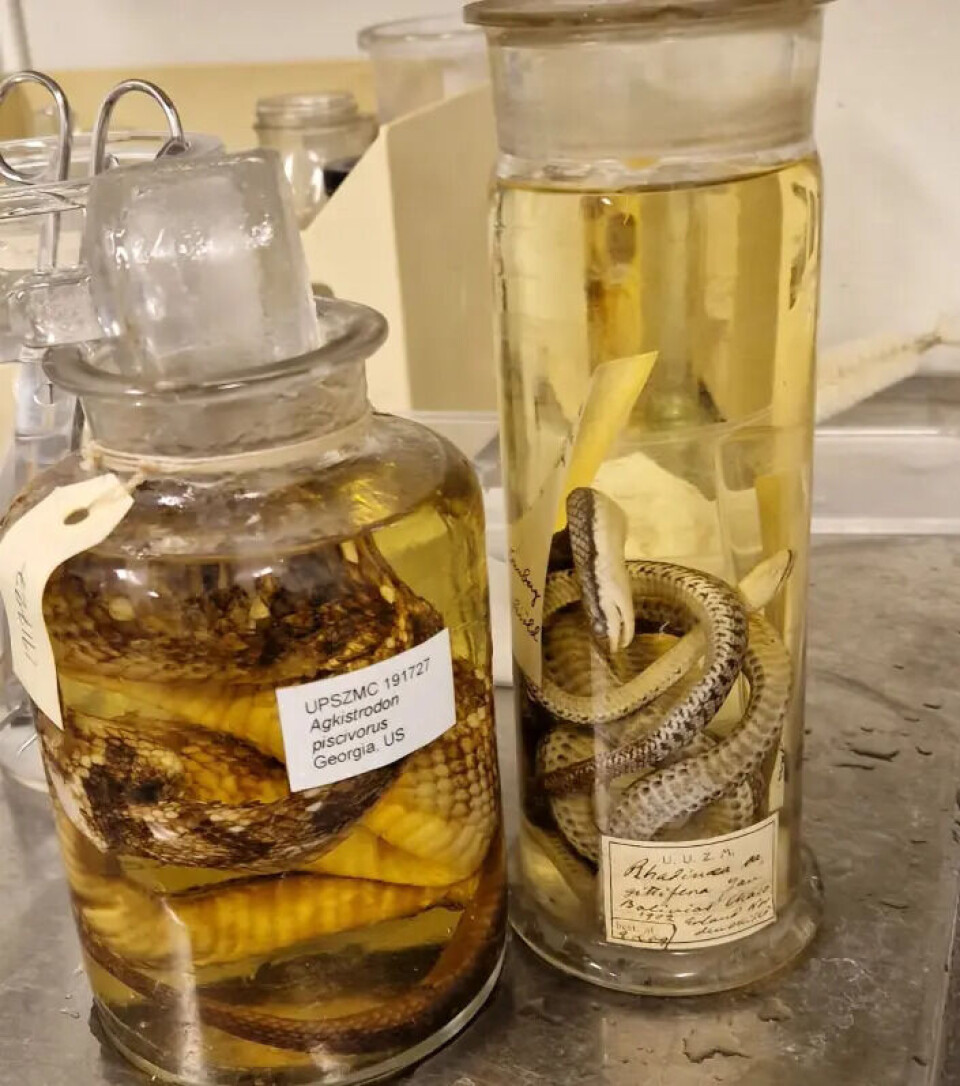THIS CONTENT IS BROUGHT TO YOU BY THE University of Agder - read more
Researchers are now examining several hundred-year-old snakes in search of a deadly disease
“We're mapping the disease to understand more about how it affects snakes and how it spreads,” says researcher.

Researchers at the University of Agder (UiA) and Uppsala University are examining hundreds of snakes from museum collections. They are looking for traces of a deadly fungal disease.

The goal is to understand more about the fungus Ophidiomyces ophidiicola, whci is its Latin name. Where does it come from, what snakes does it attack, and how long has it been around?
“We're mapping the disease to understand more about how it affects snakes and how it spreads,” says Beate Strøm Johansen.
She is a zoologist at the Natural History Museum and Botanical Garden at UiA.
By studying snake collections in museums, researchers can find out where the fungus has spread in the past. They can also find out how far back in time the fungus has affected snakes.
Fungus found in Europe
The fungus was first discovered in the USA in 2006. It came as a shock to European researchers when it was found in the UK in 2017.
The fungus first infects the skin and scales with brown and dry spots. It gradually attacks the lungs, eyes, and other internal organs. Snakes can have difficulty breathing and may become blind.
In the worst case, entire snake populations may be wiped out.
“We need to understand the extent of this disease. The fungus could have major consequences for snake species all over the world,” says Johansen.
Hoping for answers this year

Malene Ø. Nygård is a conservator and molecular biologist at UiA's Natural History Museum. She has isolated DNA from over 300 snakes and shed skins that Johansen and her students have collected.
Among the snakes are all the species found in Norway: smooth snakes, grass snakes, and vipers.
“We're excited about the results, both from the samples of the living snakes and the research we have now started on dead snakes in the collections at various museums. This could give us important knowledge both about the history of the disease and what we can possibly do to protect snakes in the future,” says Nygård.
Old snakes provide new answers
The project is a collaboration between the University of Agder, Uppsala University, and the Swedish University of Agricultural Sciences.
So far, researchers have examined around 120 snakes from the Museum of Evolution in Uppsala and the Natural History Museum in Oslo.
This autumn, they plan to study snakes at the Swedish Museum of Natural History in Stockholm and in collections in Trondheim.
Snakes in alcohol
The snakes are stored in jars and preserved with alcohol or formalin. The lids on the jars are sealed.
“We first look at the snakes through the glass. We look for brown spots and signs of infection. If we get the museum’s permission, we open the seals and collect tissue samples with a scalpel and cotton swabs. We analyse the samples under a microscope and in the DNA lab,” says Johansen.

The snakes they are examining may be several hundred years old.
“By mapping old snakes, we can find out which areas and snake species might be particularly vulnerable to the fungus,” she says.
Cannot infect humans
The fungus cannot directly infect humans. However, humans can help spread it to new areas. This can happen through soil and equipment or via escaped pet snakes that are infected with the fungus.
The origin of the fungus is still unclear. It likely resides naturally in the upper soil layer. But no one knows yet why it targets snakes.
“There are two other species of fungus that resemble the deadly one. The other two are not as dangerous but complicate the identification of the type we're looking for. It's important to accurately identify this particular deadly fungus,” says Johansen.
The Swedish public broadcaster SVT has produced a TV report about the hunt for the deadly snake fungus (link in Swedish).

This content is paid for and presented by the University of Agder
This content is created by the University of Agder's communication staff, who use this platform to communicate science and share results from research with the public. The University of Agder is one of more than 80 owners of ScienceNorway.no. Read more here.
More content from the University of Agder:
-
What is it like for nurses to promote health behind bars?
-
This can make life easier for new maths teachers
-
Norwegian women were burned at the stake here
-
Ticks can spread more than just Lyme disease and TBE virus
-
Fish help the ocean store carbon
-
New study: Early interventions against childhood obesity show no effect




































